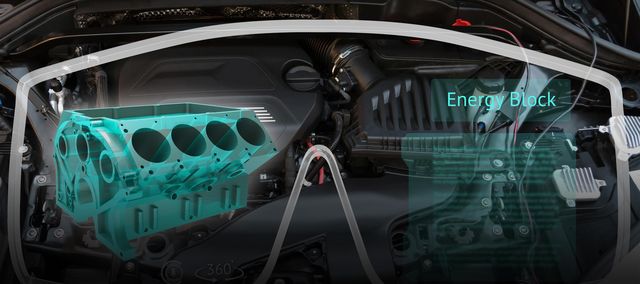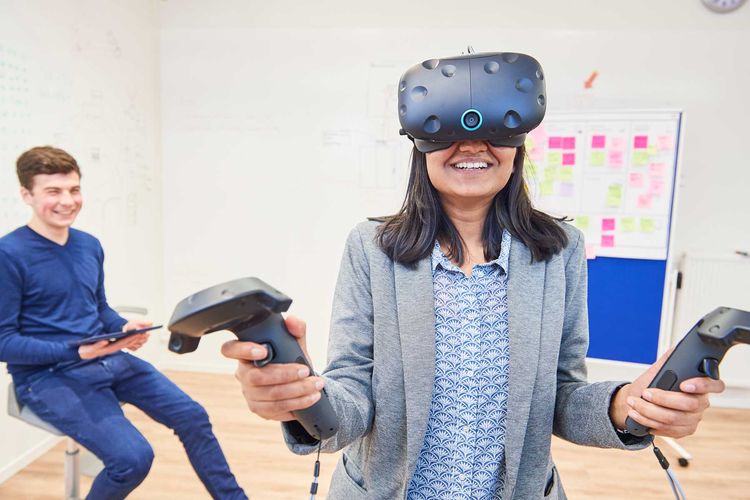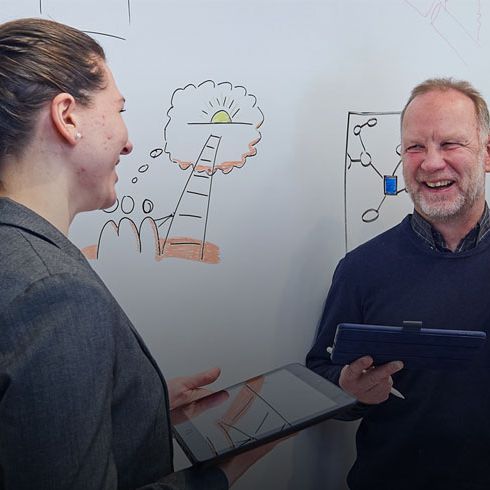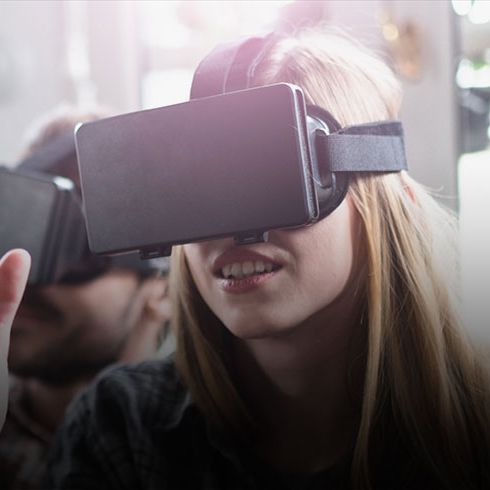26 July 2018
In computer games, theatre and film, virtual reality (VR) has for some time now been giving users that feeling of being right in the heart of the action. And now, this technology is increasingly taking centre stage in industry, the automotive sector, architecture and testing processes. The idea is for virtual or enhanced realities (AR) to pave the way to better and more efficient ways of working by introducing new methods.
Of all the numerous future technologies introduced in the cult series “Star Trek”, the holodeck is particularly popular among Sci-Fi fans. In their spare time, the crew members of the Enterprise can plunge into computer-generated worlds, roam the Wild West, turn into Sherlock Holmes or simulate medical interventions and design technical equipment. Advances in VR technology, which are opening up that feeling of being right in the heart of things to groups other than gamers, mean that the holodeck is no longer pie in the sky. With its “Virtual Reality Holodeck”, Audi can now generate a three-dimensional simulation of a car in a virtual environment in which up to six members of staff can move about. This is giving developers and production experts a realistic overall impression of a model and its proportions at an early stage. The company is thereby saving the time and costs in the development process that have until now been earmarked for photorealistic 2D computer graphics or handmade models. The intention in the next stage of development is for other employees from other branches to be invited into the virtual world, further improving work organisation.
Alongside the development work, the technology is also being used in the affiliated car dealerships, meaning that customers can already configure their dream car in the virtual world. Also VR-based is employee training in packaging logistics. Nor is Audi alone in running such projects. According to a study conducted by Deloitte, Fraunhofer and Bitkom, German companies are seeking to invest around € 850 million in VR and mixed-reality applications by 2020.
© TÜV NORD/Hauke HassSaima Ansari, innovation manager at TÜV NORD, shows the use of VR glasses.
Deutsche Bahn, for example, has developed training scenarios to avoid accidents in the coupling of carriages or to train personnel in the use of new hydraulic lifts in inter-city trains to allow wheelchair users to be safely lifted into the train. Instructing every single one of its 5,500 service personnel on real trains would be very costly and enormously time-consuming for the railway operator. A train provided for such purposes can’t carry passengers. The opportunity to provide training during scheduled operations is limited because trains are ideally expected to leave the station after no more than five minutes. Carrying out the training in virtual reality is becoming a viable alternative which offers specific preparation for real practice situations. After the training, Usman Ghias, who is overseeing the project for Deutsche Bahn, was able to use the hydraulic lift on a real train flawlessly and within the envisaged time limit – all without ever having operated a real lift before.
Alongside product development, staff training and marketing, virtual reality might also serve to speed up and improve test or assessment processes. Until now, environmental impact assessments have always needed the experts concerned to be on site in person to gain an impression of the spread of noise, light and atmospheric pollution: Where are the nearest houses? How tall are they, where are any balconies or terraces? Does the presence of sports facilities need to be considered? Is there any undeveloped land nearby? Thanks to the data from GIS and VR technologies, a town can now be geometrically modelled and virtually explored on a computer screen. For Stefan Goers from TÜV NORD, the benefits are obvious: “We have of course always made use of 2D images, but virtual reality allows us to process 3D data much more effectively. With high resolution, we can zoom in on whole roads and see for ourselves how they’ve been developed.” The experts can determine in advance where the people who are asserting their right to protection actually live and where they will need to set up their measuring equipment when they visit the site. “This will then help us get results much faster when we’re actually on site,” Stefan Goers adds.
This innovative approach was developed in the context of a pilot project. Specialists teamed up with the innovation managers from TÜV NORD. If they get their way, augmented-reality applications (AR) will in future also be used to support the experts in their work. Unlike VR, these don’t generate closed virtual worlds. For instance, if you are looking at the real environment through the display of a smart phone or tablet or through data glasses, additional information will be superimposed on your field of vision. The idea is for this extended reality to provide the inspectors in real time with further information which they need during inspections. The AR/VR experts from TÜV NORD demonstrated how this technology might help in the inspection and maintenance of power plants at this year’s Hanover trade fair. If, for instance, an inspector uses his tablet to inspect a section of pipeline, an augmented-reality app will at the same time overlay further details, ranging from technical drawings and information about welded seams to the inspection reports. It will also be possible to check the system status live using cloud-based technology, for example, to establish whether the system is without power.
Virtual and augmented reality are still in the development phase, emphasises Saima Ansari, Innovation Manager at TÜV NORD: “But they have huge potential for existing and new services. We’re working with specialists from around the Group on different deployment scenarios.” The aim is to speed up and enhance the efficiency of inspection processes with the aid of virtual or augmented reality.



